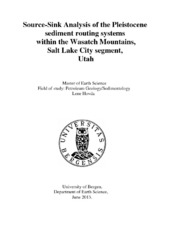| dc.description.abstract | Source-sink studies consider the sedimentary systems holistically from the erosional hinterland to the depositional basin. Such studies are often challenged by poor constraint on key parameters controlling sediment production, transport and deposition, such as base-level and climate history, drainage catchment area and lithology. The Wasatch Fault is a large active normal fault system in the northern Utah, USA. The fault zone separates the Wasatch Mountains from the Salt Lake Basin, which contained a very large endorheic lacustrine system during the late Pleistocene (Lake Bonneville). Climatic changes caused the lake level to drop in several discrete phases starting at 14.500 years B.P. leaving a series of distinct mappable shorelines. The sediment delivered to these shorelines is derived from a series of drainage catchments linked to seven major canyons that cut across the Wasatch Fault Zone. Each of these catchments drains a specific lithology in the footwall of the fault. The bedrock lithologies, including granite, quartzite, limestone and a soft, Triassic mudstone, were eroded and then deposited as alluvial fans and fan deltas at the mouths of the different canyons. This area is thus well suited for studying source- sink relationships since the recent base-level history, source area geology, climate, catchment area and the subsequent shoreline deposits are all well constrained. Catchment and fan characteristics were studied using 2 m lidar derived DEM and fieldwork, looking at lithology in the different catchments and fans. Results illustrate that the largest fans are associated with the most resistant catchment lithologies. This somewhat counter-intuitive result is because the more resistant areas of the catchment were associated with the highest altitudes and were glaciated during the Last Glacial Maximum. Glacial processes significantly increased the production of sediment. Additionally north-south longshore currents during Lake Bonneville times have been suggested to be instrumental in controlling volumes and sediments distribution along the basin. Results also suggest that the BQART model which is commonly used in source-sink studies has, in the present case, significantly underestimated the volumes of sediment supplied from catchments to the basin glaciated and to a lesser extent non-glaciated catchments. | en_US |
